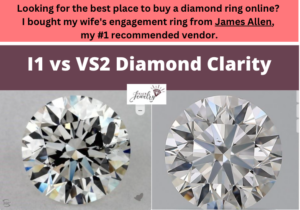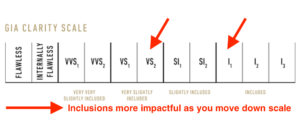
Two categories on the diamond clarity scale are included (I) and very slightly included (VS). Within these sections, two designations are I1 and VS2.
The difference between I1 and VS2 clarity is I1 diamonds have heavy inclusions that are almost always visible to the naked eye. The flaws impact its durability and appearance, so they’re rarely used in engagement rings. VS2 diamonds have small blemishes that are often only identifiable with magnification.
We’ll compare I1 versus VS2 clarity diamonds, including:
- An overview of each clarity grade
- Four differences
- How to know which is right for you
Here are the details.
What are I1 Diamonds?
I1 diamonds fall on the low end of the Gemological Institute of America’s (GIA) clarity scale.
Within the included category, there are three grades: I1, I2, and I3.
Each step down means the inclusions are more impactful. I1 is the ninth lowest position on the scale, landing one grade below SI2.
To view an I1 diamond in high-resolution, check out this round-cut diamond from the vendor where I bought my wife’s engagement ring.
Rotate the image and view it at every angle to notice how the inclusions stand out in different areas.
To contrast it with a diamond that earned a flawless grade, here they are side-by-side.

The flaws in the I1 diamond are immediately apparent. Not only are there black spots covering almost the entire table, but within the facets, there are dozens of blemishes in various positions and sizes.
Now compare it to this I2 diamond.

To the naked eye, it would be difficult to identify which is more included.
Even trained gemologists can assign unique clarity grades to the same diamond, which demonstrates how the distinctions between grades next to each other on the clarity scale often aren’t noticeable.
An I1 clarity grade isn’t referring to specific inclusions. It could have any of the following:
- Feathers
- Cavities
- Twinning wisps
- Indented naturals
- Crystals
- Etch channels
Instead, it’s an indicator of the extent those blemishes affect its overall quality and appeal.
What are VS2 Diamonds?
VS2 diamonds are positioned between VS1 and SI1 on the GIA clarity scale.

So they have more impactful inclusions than the former but less than the latter.
To the naked eye, it’s often impossible to distinguish between them.
As an example, here’s a VS2 diamond next to one graded VS1.

Now, compare it to this SI1 diamond.
Even with high-resolutions images, they appear almost identical.
Similar to I1 diamonds, a VS2 grade doesn’t mean there are certain inclusions present. It could have any combination of cavities, feathers, etch channels, bruises, and more.
But the VS2 grade means these same inclusions aren’t as impactful compared to the ones in an I1 diamond.
How are I1 and VS2 Clarity Different?
1. Number of Inclusions
In almost every case, I1 diamonds have more inclusions than ones that earn VS2.
Although clarity isn’t an indicator of a specific number, in general, more inclusions result in a lower grade.
For example, examine this I1 diamond.
There are black spots, feathers, and twinning wisps scattered across its table.
Each has several occurrences.
As a comparison, this VS2 diamond only has small crystals, pinpoints, and naturals.
But importantly, they aren’t visible, even in the close-up image.
Additionally, each inclusion is smaller. This lessens its overall effect on the diamond.
There are exceptions to this rule. I’ve examined VS2 diamonds with:
- Crystals
- Feathers
- Cavities
- Needles
The reason they still received a VS2 grade, even though there were four types of inclusions, is because they aren’t as large as the ones in the I1 diamond and have less of an affect on its performance.
I recommend choosing one with several minor inclusions, like pinpoints and needles, versus one with one or two large ones.
The latter are more likely to be noticeable and impact its structure than several small ones.
Diamonds with large inclusions can earn an I1 grade for this reason, and its impact on performance would be noticeable.
2. VS2 Sells for Higher Prices
Buyers are willing to pay a higher price for VS2 diamonds compared to ones graded I1.
They’re more visually appealing and rare, which increases demand.
To assess prices for VS2 versus I1 diamonds, I compared more than 140 diamonds from James Allen, my go-to vendor for quality jewelry.
Each round-cut was graded by the GIA and earned the following:
- Carat weight: 1.00
- Cut: Very good
- Color: G
The average price for an I1 diamond with those grades was $3,962, with a range of $2,820-$5,130.

For a VS2 diamond with those traits, the average was $7,527. The range was $7,090-$9,490.
That’s a 90 percent premium for a VS2 diamond compared to one with I1 clarity.
The I1 diamond with the highest price still costs more than the VS2 diamond with the lowest price.
But in general, you’ll pay about 20 percent more for every step up the clarity scale. That difference is often more significant if you move from one category to the next, such as SI to VS clarity.
It’s also a higher premium than you’ll pay for moving up the color scale.
While I recommend avoiding higher clarity grades and instead focusing on value at the lower end, don’t go as far down as I1 for your center diamond. Even as accents lining the shank or surrounding the main diamond as a halo, they might lack the brilliance that enhances these features.
VS2, on the other hand, often appears eye-clean and can serve as the center diamond or accents. You can also consider SI diamonds as the main diamond or accents because they have the potential for eye-cleanliness.
3. I1 Diamonds can Lack Durability
The effects of inclusions in I1 diamonds aren’t limited to visual appearance. It also impacts durability.
They represent weak points its structure that could fracture if the diamond is hit or dropped. This is especially the case if those imperfections are located in positions that are already vulnerable.
For example, fancy shapes like princess, baguette, marquise, and pear cuts have sharp points. On princess and baguette cuts, they’re on the corners.
Here’s the GIA report for a princess cut that shows needles and crystals on the corners of both the top-down and bottom-up view.

Depending on their size, I expect them to cause more durability challenges than if they were located in a different area.
On marquise and pear cuts, there are ends that narrow and reach a point.
Even without inclusions in those areas, they’re still vulnerable.
But when a flaw like a twinning wisp, feather, or bruise is located there, it weakens them even more. So protect them with a quality setting.
Bezel settings are often fit for weaker diamonds because a ring of metal wraps around it, protecting it at every angle.
The downside is it covers more of the diamond compared to a prong setting, which reduces its apparent size and brilliance. I don’t recommend a bezel setting for small diamonds.
And make sure your choice of setting doesn’t press too hard on the diamond.
This is less of an issue with VS2 diamonds. If there are inclusions in those positions, they’re more likely to be small and have minimal impact.
4. Popularity as Engagement Ring Diamonds
VS2 diamonds are often chosen for engagement rings because of their eye-cleanliness and lower price compared to ones in the VVS or flawless category.
But in my case, I chose a VS1 clarity diamond for my now-wife. It resulted in a slight premium compared to VS2, but the diamond’s other qualities were the right fit.
If you choose a brilliant cut, the inclusions won’t have a significant impact on its brilliance.
Don’t be concerned with the specific clarity grade for your engagement ring diamond.
Instead, focus on how it appears when viewed in a normal setting. This concept applies to its color grade as well, which is why G and H color grades are popular.
In the same way I1 diamonds cost less than VS2 diamonds, the latter also commands a discount because of its inclusions.
In fact, if you opt for VS2 over flawless, you could save up to 50 percent on the diamond and put that savings toward improved color or cut or a heavier gem.
It’s rare to find an I1 diamond on an engagement ring. Visible inclusions, especially ones as large and dark as typically found on an I1 diamond, diminish its appearance.
On the other hand, this diamond ring has inclusions but still sparkles like a flawless one.
Start your search with SI1, but if your diamond is heavier than one carat, you’ll likely find the right pick at VS2 or VS1.
Should You Choose an I1 or VS2 Diamond?
Choosing between an I1 versus VS2 clarity diamond involves understanding how inclusions affect its overall quality and performance.
It’s one of the most important characteristics of a gem, and the 11 grades on the GIA clarity scale leaves you with many choices.
My recommendation is avoid I1 diamonds. Instead choose one where the inclusions are only visible with magnification. VS2 diamonds often fit this criteria.
This also applies to small diamond accents that complement the main one. Be careful going as far as I1 with these either, although you might find I1 accents that are sufficient.
But the SI range offers value because the inclusions aren’t apparent and the price isn’t as high.
Whether you’re searching for an I1 or VS2 diamond, or one with a different clarity grade, take the time to assess all the options available for your ring.

Jacob Clarke
Jacob Clarke is the founder of TeachJewelry.com.
He earned an Applied Jewelry Professional Diploma from the Gemological Institute of America (GIA) and now brings you essential information about diamonds, settings, and more.
Jacob has consulted with leading jewelry brands, and his work has been cited in Clean Origin, Diamond Nexus and industry publications.
He's also a member of the International Gem Society.
He enjoys discussing jewelry with readers, so contact him with any questions at jacob.clarke@teachjewelry.com.
















